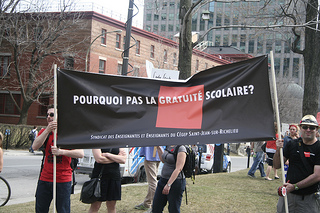In the context of student protests over Quebec tuition fees, my friend Luan Ngo has just written a very informative blog post on Quebec’s fiscal situation.
While I encourage readers to read his full post, I do want to use the present space to make mention of three important points he makes:
– On a per capita basis, Quebec spends more on government programs than most other Canadian provinces.
– Residents of Quebec pay more personal incomes taxes than any other province.
– Quebec’s debt-to-GDP ratio is significantly higher than that any other Canadian province.
He argues that, in light of the above, “Quebec is in a bind, stuck between a rock and a hard place.”
While I believe Luan makes an extremely important contribution to the debate, I think it’s crucial to make mention of the role of the federal government. I would argue that successive federal governments have in fact brought on this so-called crisis.
When Paul Martin was federal finance minister, he brought in several tax reductions. One was the $100-billion tax-cut package he brought in with the 2000 federal budget; he also brought in important reductions to capital gains taxes. By the time Chretien/Martin left office, the federal government’s fiscal capacity (annually, and assuming a balanced budget over the business cycle) had been reduced by approximately $30 billion. After the Harper government came to power in 2006, this trend continued, as the Harper government continued what Chretien/Martin had started (including a reduction in the GST).
It therefore won’t surprise many readers to learn that, while the federal government at one time covered 80 per cent of a typical Canadian university’s operating budget, today the federal government covers just 50 per cent of a typical university’s operating budget. If you’re a federal government, it seems you can’t have your cake and eat it too!
Thus, I would argue that the current “crisis” in Quebec over tuition fees has been largely created by successive federal governments that have defunded Canadian universities, indeed putting provincial governments “between a rock and a hard place.”
And if successive federal governments have taken us in one direction on taxation levels, they also (if they so choose) have the option of reversing course. What goes up can also go down, and vice versa.
Finally, I feel it would be irresponsible for me not to point out that there are schools of thought (ones that are becoming somewhat more prominent in light of the financial crisis) that do not accept a lot of the limits and boundaries of neoclassical economics. Some economists have argued, for example, that if a central bank keeps real interest rates low (but positive) over the long term and allows for moderate inflation, a country with its own currency can increase spending very substantially over the long term without increasing taxes. PEF Blogger Arun Dubois has blogged extensively about some of these other perspectives.
This article was first posted on The Progressive Economics Forum.




